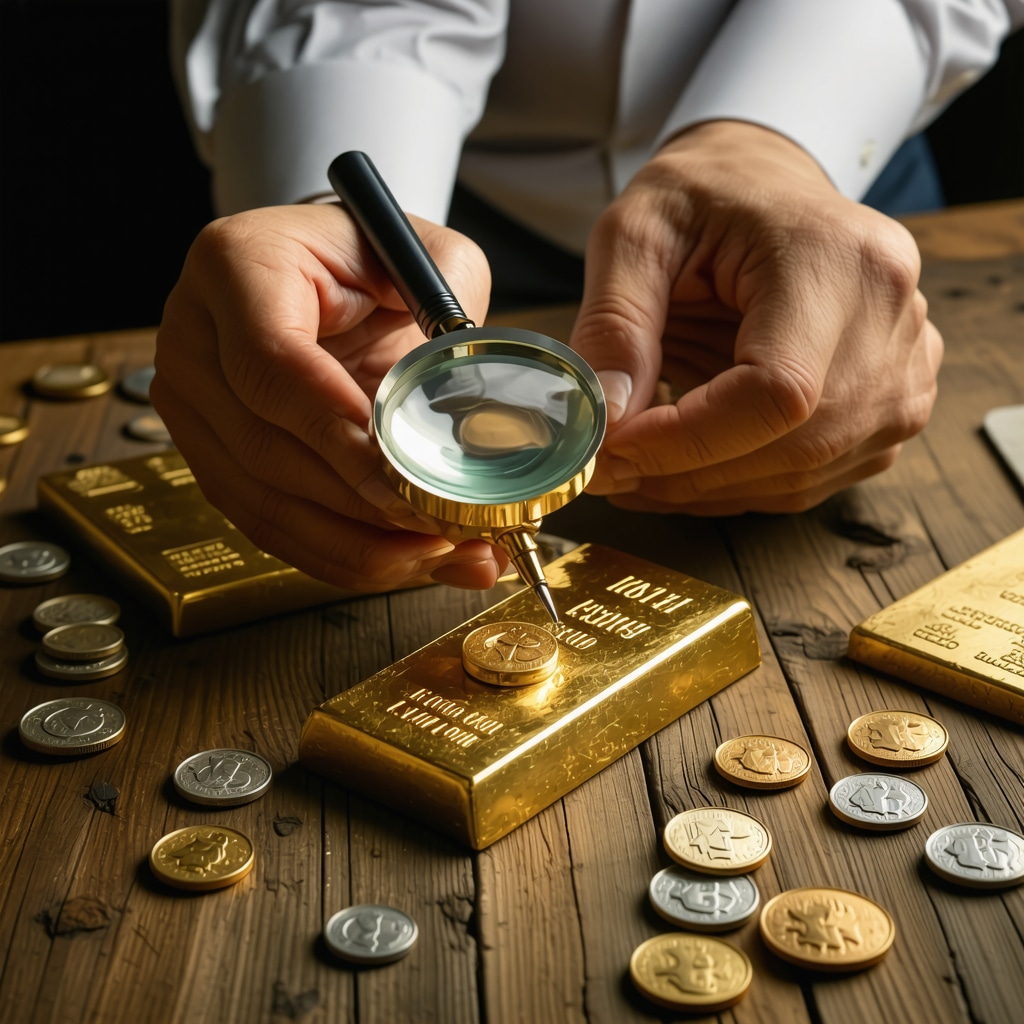Elevating Physical Gold Investments Through Rigorous Authenticity Verification
In the complex landscape of physical gold investments, ensuring authenticity transcends mere precaution—it is an imperative that safeguards both capital and trust. As bullion and coins remain pivotal in diversified portfolios, the challenge lies in discerning genuine assets amidst sophisticated counterfeits. This necessitates a multi-layered verification approach rooted in expert knowledge, advanced technology, and meticulous due diligence, which collectively uphold the integrity of physical gold holdings.
Advanced Authentication Techniques: Beyond Traditional Assays
While conventional methods such as acid testing and weight measurement provide foundational verification, contemporary investors must leverage enhanced technologies like X-ray fluorescence (XRF) analyzers and ultrasonic testing. XRF devices offer non-destructive elemental composition analysis, confirming purity levels with precision. Similarly, ultrasonic testing detects internal inconsistencies, revealing potential adulterations invisible to surface inspections. These tools, often utilized by professional assayers and reputable dealers, significantly reduce risks of counterfeit acquisition.
What Are the Industry-Standard Certifications and Hallmarks That Guarantee Gold Authenticity?
Understanding and recognizing hallmarking standards is crucial. Trusted certifications, such as those from the London Bullion Market Association (LBMA) or the Swiss Assay Office, attest to gold’s fineness and origin. Each coin or bar should bear a hallmark indicating purity (e.g., 24K or 999.9), manufacturer’s mark, and assay certification. Discrepancies or absence of these marks necessitate further scrutiny. Engaging with certified dealers who adhere to these standards ensures compliance and trustworthiness in transactions.
Strategic Due Diligence: Selecting Reputable Dealers and Secure Storage
Securing authenticity begins at the point of purchase. Investors must prioritize dealers with verifiable credentials, transparent sourcing, and positive industry reputations. Utilizing resources such as how to find trusted gold dealers for safe and reliable buys guides informed decision-making. Post-purchase, appropriate storage—whether in insured vaults or allocated safe deposit boxes—further protects against theft and tampering, maintaining the asset’s integrity over time.
Integrating Physical Gold Within a Holistic Wealth Preservation Framework
Authenticity verification is a cornerstone of effective gold investment strategies that hedge against inflation and market volatility. Layered with professional-grade authentication and secure handling, physical gold becomes a resilient asset class. For comprehensive insights on maximizing gold’s strategic advantage, readers can explore smart gold investment strategies for steady wealth growth, which elucidate integration tactics within diversified portfolios.
For further authoritative guidance on physical gold authenticity and secure investment practices, the World Gold Council provides extensive research and certification standards accessible through their official publications (World Gold Council).
Explore more expert-level analyses and contribute your insights on trusted gold investment techniques by visiting our dedicated resource hub.
Leveraging Digital Tools for Enhanced Gold Authentication
In the evolving gold market, digital advancements have introduced innovative methods for verifying gold authenticity. Blockchain technology, for example, is increasingly adopted to provide immutable records of gold provenance. Through digital certificates and traceability platforms, investors can verify the entire journey of their gold assets, from mine to market. This transparency mitigates risks associated with counterfeit or illicit gold, raising the standard for trust in physical gold transactions.
Augmented reality (AR) applications are also gaining traction, enabling investors and dealers to inspect gold coins and bars virtually with detailed overlays about their purity, weight, and hallmark validity. These technologies complement traditional authentication methods and provide a modern layer of security that is both accessible and user-friendly.
How Can Investors Effectively Integrate Emerging Technologies to Fortify Their Gold Investment Security?
Navigating the intersection of technology and precious metals investment requires a strategic approach. Investors should assess the credibility and adoption rate of digital authentication platforms, ensuring they partner with entities recognized by industry authorities such as the LBMA. Additionally, combining digital verification with physical examination enhances due diligence rigor. This dual approach not only protects against fraud but also facilitates smoother transactions in secondary markets.
Advanced Storage Solutions: Beyond Conventional Vaults
Secure storage remains paramount; however, innovation in this arena has introduced options beyond traditional bank safety deposit boxes. Professional vault storage services now offer insured, climate-controlled environments with state-of-the-art security systems including biometric access, 24/7 surveillance, and multi-factor authentication protocols.
Furthermore, allocated storage solutions, where the investor’s specific gold holdings are segregated and individually identifiable, offer greater protection compared to pooled storage. Such arrangements ensure that investors maintain direct ownership, reducing counterparty risk prevalent in some storage schemes.
For those seeking convenience without sacrificing security, some custodians provide integrated services that combine physical storage with digital portfolio management, enabling real-time asset tracking and valuation.
Understanding Market Dynamics: The Impact of Central Bank Gold Purchases on Price Stability
Central banks continue to play a critical role in shaping gold market trends through their purchasing activities. Increased acquisitions by central banks often signal confidence in gold’s role as a reserve asset, influencing market sentiment positively.
For instance, recent analyses by the International Monetary Fund highlight how coordinated central bank buying can tighten supply, driving prices upward and enhancing gold’s appeal as a safe haven during economic uncertainty (IMF Working Paper on Central Bank Gold Purchases).
Investors attuned to these macroeconomic signals can better time their entry and exit points, optimizing portfolio performance amid fluctuating market conditions.
Delve deeper into how central bank gold purchases influence global prices and market strategies in our detailed article on analyzing central bank gold purchases and global impact.
Engage with our community by sharing your experiences or questions about integrating advanced authentication and storage methods in gold investing. Your insights help foster a smarter, more secure investment environment.
Blockchain-Enabled Provenance: Revolutionizing Gold Traceability and Investor Confidence
The integration of blockchain technology into the gold supply chain is not merely a trend but a transformative leap toward unparalleled transparency and security for investors. By encoding provenance data onto immutable ledgers, each gram of gold can be traced from extraction through refining, minting, and finally to the end investor’s hands. This tamper-proof record mitigates risks associated with fraud, conflict gold, and unauthorized recycling, thereby elevating trust among stakeholders.
Leading industry initiatives, such as the Responsible Gold Initiative, leverage blockchain alongside traditional certification to authenticate ethical sourcing and refine the due diligence process. As a result, investors gain access to real-time, verifiable data about their gold’s origin and handling, fostering enhanced portfolio integrity.
What Are the Practical Challenges and Solutions in Adopting Blockchain for Gold Authentication?
Despite its promise, blockchain adoption in physical gold markets encounters hurdles including interoperability among various platforms, data input accuracy, and industry-wide standardization. Successful implementation requires collaborative frameworks between miners, refiners, assay offices, and dealers to ensure consistent and reliable data entry.
Advanced sensor technologies and IoT devices are increasingly deployed at extraction and processing points to automate and secure data capture, minimizing human error. Moreover, consortiums like the LBMA’s Responsible Sourcing Program are spearheading efforts to establish universal protocols that harmonize blockchain use within the gold ecosystem.
Investors should thus seek gold products certified through blockchain-enabled provenance systems verified by recognized authorities to maximize security benefits.
Applying Predictive Analytics to Anticipate Gold Market Movements: A Quantitative Approach
Beyond authentication, sophisticated investors harness predictive analytics and machine learning algorithms to decode complex market signals that influence gold prices. By analyzing vast datasets—including macroeconomic indicators, geopolitical events, central bank policies, and social sentiment—these models generate actionable forecasts informing optimal buy, hold, or sell strategies.
This data-driven approach transcends traditional technical analysis by incorporating alternative data sources such as satellite imagery of mining activity and transactional flows on blockchain networks. These insights provide a competitive edge in anticipating shifts in supply constraints or demand surges.
Integrating these analytics into portfolio management platforms enables dynamic rebalancing aligned with evolving market conditions, facilitating enhanced risk-adjusted returns for gold investors.
Innovations in Physical Gold Security: Biometric and AI-Driven Vault Systems
Security innovations are rapidly advancing beyond conventional vaults to incorporate biometric authentication and artificial intelligence (AI) for threat detection and access control. Modern storage facilities employ fingerprint, iris, or facial recognition systems combined with AI-powered video analytics to monitor and respond proactively to suspicious activities.
These technologies reduce reliance on manual oversight and improve response times to potential breaches. Additionally, AI algorithms analyze access patterns to detect anomalies indicative of insider threats or attempted fraud, thereby reinforcing the security perimeter safeguarding physical gold assets.
How Do AI and Biometric Systems Enhance Custodial Confidence Without Compromising Privacy?
Balancing robust security with privacy concerns is a key consideration. Leading vault providers implement stringent data encryption and access governance policies to protect biometric data. Furthermore, decentralized AI processing ensures sensitive information is analyzed locally rather than transmitted, reducing exposure to cyber risks.
Transparency around data usage and compliance with regulations such as GDPR fosters user trust. Investors are encouraged to inquire about custodians’ security protocols and privacy safeguards to ensure their gold holdings benefit from cutting-edge protection technologies without compromising personal data integrity.
Future-Proofing Gold Investments Through Integrated Digital-Physical Ecosystems
The convergence of physical gold assets with digital identity and verification systems heralds a new era of investment security and liquidity. Platforms are emerging that combine secure storage, blockchain provenance, real-time market analytics, and AI-driven risk management into unified dashboards accessible via mobile and desktop applications.
This integration empowers investors to monitor authenticity, track market dynamics, and execute transactions seamlessly while maintaining direct ownership of their gold holdings. Such ecosystems promise to reduce friction in secondary markets and expand accessibility to gold investments globally.
To deepen your expertise on leveraging these cutting-edge technologies for gold investment security, explore our advanced resource library and join interactive webinars with industry experts.
Harnessing Quantum Technologies for Next-Generation Gold Verification
Quantum sensing and spectroscopy are emerging as revolutionary tools in the domain of precious metal authentication. These technologies exploit quantum states to detect elemental and isotopic signatures with unprecedented sensitivity and specificity. Unlike traditional methods, quantum sensors can identify subtle impurities or synthetic alterations, ensuring the utmost fidelity in gold purity verification. Early adoption by specialized assay laboratories foreshadows a paradigm shift towards ultra-precise authentication protocols.
Collaborative Ecosystems: Synergizing Blockchain with IoT for Real-Time Gold Provenance
The integration of Internet of Things (IoT) devices with blockchain ledgers creates a dynamic provenance network that continuously monitors gold’s lifecycle. Smart sensors embedded in transport containers and storage units relay tamper alerts and environmental data, automatically updating decentralized ledgers. This real-time synchronization enhances transparency, deters illicit activities, and supports compliance with international gold trade regulations. Stakeholders across mining, refining, and retail sectors benefit from this interconnected framework, which also facilitates streamlined audit processes.
What Are the Critical Protocols for Ensuring Data Integrity in Blockchain-IoT Gold Authentication Systems?
Maintaining data integrity within blockchain-IoT ecosystems requires robust encryption, secure key management, and resilient consensus mechanisms. Protocols such as Zero-Knowledge Proofs (ZKP) enable verification without exposing sensitive information, preserving confidentiality while ensuring authenticity. Additionally, periodic third-party audits and cross-validation with physical assays mitigate risks of erroneous or fraudulent data entries. Industry consortia, including the Responsible Gold Initiative, advocate standardized frameworks to harmonize these protocols, promoting interoperability and trustworthiness.
Augmented Reality and AI-Enhanced Visual Verification: The New Frontier for Investors
Augmented Reality (AR) applications, augmented by Artificial Intelligence (AI), empower investors to conduct rapid, non-invasive visual inspections of gold assets. AI algorithms analyze visual data for hallmark verification, surface anomalies, and microstructural patterns invisible to the naked eye. When paired with AR overlays, users gain an interactive experience that contextualizes authenticity metrics and provenance histories. This fusion of technologies democratizes expert-level assessments, increasing confidence for individual and institutional investors alike.
Decentralized Finance (DeFi) Meets Physical Gold: Innovative Custodial Models
The convergence of DeFi platforms with physical gold custody introduces liquidity and fractional ownership paradigms previously unattainable. Tokenized gold assets, backed by authenticated physical reserves, enable seamless trading on blockchain exchanges while preserving tangible asset security. Custodians leveraging AI-driven security protocols and multi-signature wallets ensure asset protection against cyber and physical threats. This hybrid model redefines accessibility, allowing diversified portfolios with enhanced transparency and regulatory compliance.
For further in-depth exploration of these advanced gold investment modalities, the World Gold Council Research offers authoritative insights and empirical studies underpinning these innovations.
Engage with these advanced methodologies to elevate your gold investment strategy—explore our expert webinars and exclusive whitepapers today.
Expert Insights & Advanced Considerations
Integrating Multi-Modal Authentication Enhances Security
Combining traditional assays, such as hallmark verification and weight analysis, with advanced technologies like X-ray fluorescence (XRF), blockchain provenance, and AI-driven visual inspection creates a robust defense against counterfeiting. This layered approach reduces blind spots inherent in any single method and strengthens investor confidence in gold authenticity.
Blockchain and IoT Synergy Elevates Provenance Transparency
The fusion of blockchain with Internet of Things (IoT) devices establishes a live, tamper-evident ledger of gold’s journey from mine to market. Smart sensors feeding real-time data into decentralized ledgers enable continuous monitoring, mitigating risks of illicit sourcing and unauthorized handling. This approach is becoming a standard for ethical and secure gold investments.
Predictive Analytics Empower Market Timing and Risk Management
Utilizing machine learning models that analyze macroeconomic trends, central bank activity, geopolitical shifts, and alternative data sources provides investors with forward-looking insights. These analytics inform strategic entry and exit points, complementing authenticity verification by maximizing portfolio resilience amid dynamic market conditions.
Biometric and AI-Enabled Vault Systems Redefine Security Protocols
Advanced storage solutions leveraging biometric identification and AI-based surveillance transform custodial safeguards. These systems proactively detect anomalies and insider threats while maintaining privacy through encrypted, decentralized data processing, ensuring physical gold assets are protected without compromising investor confidentiality.
Quantum Sensing Foreshadows Next-Generation Purity Verification
Emerging quantum spectroscopy techniques promise unparalleled precision in detecting elemental and isotopic signatures within gold specimens. Early adoption by specialized assay laboratories indicates a future where ultra-sensitive, non-destructive testing will become a cornerstone of authenticity assurance.
Curated Expert Resources
World Gold Council Research: The definitive source for comprehensive reports on gold market trends, responsible sourcing, and technological innovations in authentication. Their research underpins many industry best practices and emerging standards (https://www.gold.org/research).
London Bullion Market Association (LBMA): Provides authoritative certification schemes, responsible sourcing programs, and guidelines critical for verifying gold purity and ethical provenance, essential for professional investors and dealers (https://www.lbma.org.uk/).
International Monetary Fund (IMF) Working Papers: Offer in-depth analysis on central bank gold purchases and their impact on market dynamics, aiding strategic investment timing (IMF Working Paper on Central Bank Gold Purchases).
Responsible Gold Initiative Consortium: An industry collaboration advancing blockchain and IoT integration for traceable, ethical gold supply chains, providing practical frameworks and protocols (https://responsiblegold.org/).
Augmented Reality & AI Authentication Solutions: Emerging tech providers specializing in AR overlays combined with AI diagnostics empower investors with non-invasive, expert-level visual verification tools. Exploring these platforms offers a modern edge for physical gold authentication.
Final Expert Perspective
Mastering physical gold investments today demands more than conventional buying and storage practices; it requires embracing a multidisciplinary approach to authenticity verification. The intersection of blockchain, IoT, AI, and quantum sensing is not just enhancing security but fundamentally reshaping trust frameworks within the gold market. Investors who integrate these advanced methodologies position themselves to safeguard their holdings effectively while capitalizing on market opportunities signaled by sophisticated analytics and macroeconomic insights.
To deepen your expertise, consider exploring our comprehensive guides on physical gold investment authenticity and strategic gold portfolio growth. Engage with the community by sharing your advanced insights or questions, thus contributing to a more secure and informed gold investment environment.










